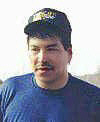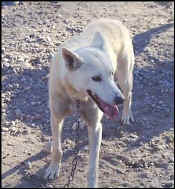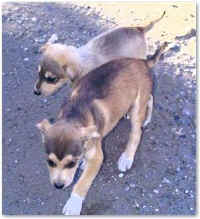Meet Curtis
Erhart
Top Alaskan Sprint Musher

Name:
Kennel:
Birthplace:
Home Town:
Occupation:
E-mail: |
Curtis R. Erhart
C & S Kennel
Tanana, Alaska
Fairbanks, Alaska
Operator in a refinery for Arco Alaska Inc.
cserhart@acsalaska.net |
[Click on any photo on this page to
view a larger version and more photos.]
Introduction

Photo courtesy of Lisa Fallgren-Stevens |
I was born in 1962 in the village of Tanana, Alaska to the parents of
Lester and Gladys Erhart. I come from four generations of dog mushers, as they were used
in our subsistence lifestyle (i.e., the trapline, traveling). My grandfather, Harold
Woods, started racing in the early 1930's, and my parents continued this tradition
themselves and by passing it on to the next generation (their children).
In 1985 I married my wife, Shannon, the youngest daughter of Gareth Wright. We have
three children: daughter, Carey, sons, Lester and Gareth. They are now the fifth
generation of dog mushers.
Together we have combined two great bloodlines of sled dogs and family traditions to
form a competitive dog kennel.
Background
My family specialty is sprint mushing, but I have a desire to try mid-distance. I
support many long distance mushers with knowledge and technique and even dogs from my
kennel. I just love to train dogs!
I have been involved with dogs all of my life and racing for 32 years. I started as a
junior when I was five years old in the one dog class, and have been racing ever since.
One of my earliest memories of driving a team of dogs was hauling fire wood with my dad.
He was driving a team of eight dogs, and I was following with a three dog team. It felt so
great to be driving a dog team.
Growing up in the village we didn't have TV and not as much outside contact as toady's
youth. So we did not have the sports heroes like toady's Michael Jordan, Tiger Woods, and
Mark McGuire's. Our heroes were the great dog musher of Alaska! I grew up around the great
native mushers like Carl Huntington, George Attla, and Gareth Wright, who to this day have
a great influence over me.
Kennel Management
What size kennel do you operate?
We maintain our kennel around 80 adult dogs (yearlings and older), with 10-12 litters of
pups a year. We raise enough dogs to keep our racing team filled, and to help out our
friends.
What type of tether/bowl system do you use?
Our dogs are tied on stakes with chains. We are slowly converting to the swivel on the end
of the stake. All dog houses have coffee cans nailed to the side, so in the summer they
have water to drink when they want it, and in the winter we don't have to look for their
cans in the snow. The whole kennel is fenced in by a 6 foot fence, to keep loose dogs in,
and stray dogs out. Our puppies are kept in pens until they are around 4-5 months of age,
depending on space.
What are the most important considerations in housing sled dogs?
Things to consider when housing your dogs are: temperature, weather conditions, and
location. Dogs need to have a place to sleep in the summer where they can get out of the
sun, and in the winter where you can provide bedding to keep them warm. This holds true
for different weather conditions too-cover from rain and snow, and something to provide
shade. You also have to consider your location. Depending on where you live you have to
think about your neighbors, are you to close to roads, can stray animals get into your
yard, etc.
Give us an overview of your feeding program.
Our dogs grow up on Alaskan fish and rice and fat or meat scraps, that we cook for them.
We then add Eagle dry dog food for their
carbohydrates. When it comes to race time we switch our racing team over to meat, like Champaine Race Mix, and continue with Eagle
dog food. We continue to cook for our pups year round. If we run out of fish we will feed
them chicken.
Summarize your basic kennel management style.
Raising a large kennel teaches you to be as efficient as possible. Our days normally start
out by starting the dog pot, then we water the dogs (during the winter, our dogs are
watered warm baited water min. 2qts. per dog), and in the summer we keep their cans filled
with fresh water. We use a four wheeler and trailer to haul two thirty gallon trash cans
filled with water so we don't have to walk out of the kennel every time we run out of
water. Then the cleaning is started, or during the summer we work with the puppies.
Afternoons are spent training the dogs during the winter, feeding is done after that.
During the summer we sometimes feed in the mornings to avoid the heat of the day, and to
give us more time to enjoy the summer.
The Dogs
 |
| Up and coming leader: Salt |
What breed(s) do you work with?
Our bloodlines originate from Lester Erhart and Gareth Wright's Aurora Huskies. We have
also crossed in the Wright-Champaine line. We are currently crossing in the Raitto hound
line.
What physical characteristics do you look for in your dogs?
These dogs have proven to be universal in their abilities, because of theses traits: good
coats, good feet, and good eaters and drinkers. Plus lots of attitude. This bloodline has
proven itself in all race classes: SPRINT, MID AND LONG DISTANCE.
What mental or emotional attributes do you require in your dogs?
A race dog needs to have a strong head, especially in sprint. They have to be able to take
the pressure of running 18-24 mph, for thirty miles. They should also have attitude and be
happy. But no matter how hard you work with a dog, a shy dog will appear, and this dog
does not care for people, but they love to run, and they are a top notch dog.
Puppies
What criteria do you use for selecting breeding stock?
Raising puppies is a time consuming thing. Your have to pick who to breed. Normally you choose the female that has
all the characteristics you are looking for plus the best bloodlines. Then you look at the
male that has proven himself in your team or other teams. Sometimes the best female isn't
even in your main team, but she came from good stock, and her siblings proved themselves.
Then you hope that you get 1-2 top pups from that litter. choose the female that has
all the characteristics you are looking for plus the best bloodlines. Then you look at the
male that has proven himself in your team or other teams. Sometimes the best female isn't
even in your main team, but she came from good stock, and her siblings proved themselves.
Then you hope that you get 1-2 top pups from that litter.
What method do you use for starting pups?
Shannon is the early trainer of the pups. She starts to run them loose behind a 3 or 4
wheeler when they are six weeks old. We have house dogs that the pups look to as a
surrogate mother and follow them. Start out short and work up to 3-5 miles, by the time
they are four months old. This teaches them to run and stretch out, before they ever have
to learn to pull.
What is the most important thing you look for in a young dog?
The most important thing to look for in a young dog is a smooth gait and attitude. When we
run the puppies at such a young age we usually keep the four to five best in a litter,
then they will be tied up and become harness broke. By the time the dog becomes a yearling
we will know if it will make the team.
Training
What is the training/racing philosophy of your kennel?
The training philosophy of our kennel, the four P's: Poor Preparation, Poor Performance.
Do you have specific training goals for your team(s)?
We believe in training our dogs to be tough (having good work ethic). Try to expose the
dogs to different types of obstacles. To train a dog to know it can complete a certain
distance. I think a four wheeler is the most important early training equipment. It allows
you to have control of your team before there is enough snow to train on a sled.
Racing
Do you having a mushing career goal?
My Mushing career goal is to win the Open Fur Rondezvous and the Open North American.
How do you choose which races to enter?
Choosing races usually follows our training schedule working up to these races. Races also
depend on my work schedule.
What are your strengths as a racer?
My greatest strength as a racer, is to be the hardest working member of the team!
What does it take to win?
A well trained dog team, and a lot of luck!
The Future
What is your vision of the future of sled dog sports?
To have open sprint racing be more recognized again.
What can individual mushers do to support and promote the sport?
Become involved, by volunteering with a club, or just showing up to support a race.
What part do clubs and organizations play in sport development?
A major part. If we didn't have these organizations there would be no races.
What advice would you give a beginning musher?
Make sure this is something you really want to do. Make sure you have enough money to care
for the dogs (feed and vet bills), you have enough time to spend with them, they have to
be fed and watered every day (no more spur of the moment vacations). Start with proven
bloodlines. Go see the top dog mushers and ask questions. Even think about becoming a
handler with a musher in the field you choose, to learn.
Anecdote
Tell us about one or two of your most memorable sled dog experiences.
In 1983 was the first time I ran in the Open North American Championship.
I was competing against George Attla, Doc Lombard, Harris Dunlap, and
Gareth Wright. I won the 2nd heat of the race, and beat these great heroes
of mine. I thought to myself- I MADE THE BIG TIME!
Comments
Any final comments about sled dog sports?
Dog Mushing is a small world, value friendships.
More Photos
[back to Interview list]

top of page |
home |
feedback | search

|



